#literary alchemy
Text
The Wizard of Oz's Name
I was watching Jeopardy! today, and one of the categories was 'full names of imaginary characters.' One of the answers was the Wizard of Oz. Turns out this was his real name (from Wikipedia):
Oz explains that his real name is Oscar Zoroaster Phadrig Isaac Norman Henkle Emmannuel Ambroise Diggs. To shorten this name, he used only his initials (O.Z.P.I.N.H.E.A.D.), but since they spell out the word pinhead, he shortened his name further and called himself "Oz"
I don't think I ever thought about what the Wizard's real name might be when I watched the film. But if I did, I would have guessed it came from Shelley's poem "Ozymandias," about the Egyptian Pharoah Ramses II. Clearly that's wrong.
As I've written before, L. Frank Baum, the author of the Oz stories, was a follower of Madame Blavatsky, a founder of the Theosophical Society in 1875. Theosophy is a mystical movement that draws on the ideas of spiritual alchemy, and Baum's fantasy novels are exquisite examples of literary alchemy.
You can see the influence of alchemy in Baum's choice of names for the Wizard, who plays the role of the alchemist in the story: he transforms Dorothy and her companions.
"Zoroaster" is a nod to the Persian sage Zarathustra (fl. c. 1000 BCE), the founder of Zoroastrianism. Zoroaster is the Greek form of his name and the name by which he is known in European sources. Many alchemical ideas can be traced to Zoroastrianism, such as the Sacred Fire and the Four Elements, as I've written before.
More importantly, "Zoroaster" is a nod to the 1667 alchemical work Zoroaster's Cave.
So "Zoroaster" is a clear alchemy reference. "Diggs" might be alchemical as well. In the original treatises of physical alchemy, the would-be alchemist, the adept, is told to seek the philosopher's stone by digging under the earth. Think of the seven dwarfs in Snow White, as an obvious example of this idea being used in a story.

12 notes
·
View notes
Text
I need more people talking about the TTPD album color, white, as it relates to “The Alchemy,” since albedo—the whitening—is one of the four stages of the alchemical process/magnum opus (the great work), which comes after nigredos—the blackening—and before citrinas—the yellowing—and rubedo—the reddening—(though the latter two started being combined after the 15th century).
We’ve got a song called “The Alchemy,” on a four part album, represented by the color of one of the four stages, introduced with a quote including veins of pitch black ink, and clowning about Reputation, represented by black, and an orange (i.e. yellow+red) door??
C’mon y’all, there is so much to mine right there without even scratching the surface of literary alchemy, but I am not smart enough to do it by myself!! Help me out here!!
#they survived The Great War but not The Great Work#the tortured poets department#ttpd#ts11 theories#the alchemy#Taylor Swift#tswift#ts reputation#orange door#alchemy#literary alchemy#come clown with me - I’m dying out here#ttpd theories#ttpd speculation#from the junk drawer
4 notes
·
View notes
Text
Very interested in “The Alchemy” considering how “gold” was Taylor’s symbol for Joe and their love.
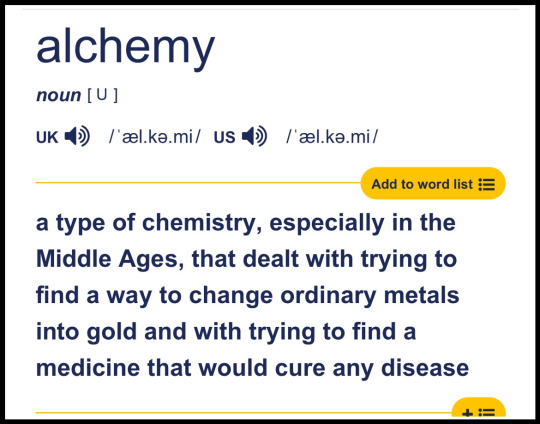
#I love analysing romantic literary techniques#sorry#taylor swift#the tortured poets department#ttpd#tpd#alchemy#gold rush#daylight#invisible string#reputation#rep tv#folklore#lover#joe alwyn#the alchemy
50 notes
·
View notes
Text
One does not become enlightened by imagining figures of light, but by making the darkness conscious.
Carl Jung, from Psychology and Alchemy, 1944
#carl jung#psychology and alchemy#psychoanalysis#enlightenment#consciousness#literary text#quotes#dark acadamia aesthetic#classic literature
179 notes
·
View notes
Text



#YELLINGGGG#i am feeling dreadful and need to sort out my tablets but THEN i am racing to get these outfits!!!!!!#aaaa#save me Literary Meditation Faust#jenji plays#alchemy stars#Faust#True Order
5 notes
·
View notes
Text
the youth today keep saying things like “i could write the great gatsby & make it better” and, well, it makes me insane 💌
#the great gatsby#no you couldn’t#the great gatsby is literary alchemy#the objectively lovely balance of the sentences#the synesthesia#if the fucking yellow jazz at the party doesn’t make pretty lights go off in your brain…#i remember reading that book for the first time in 8th grade and being stupefied that words could Do That
12 notes
·
View notes
Text
Timothy Materer. Modernist Alchemy: Poetry and the Occult. Cornell Unversity Press, 1995. Hardcover. 218 pages.
Shop link in bio.
instagram
#occult#bookseller#esotericism#poetry#modernist literature#modernism#literary studies#booksellers#academic books#western esotericism#alchemy#tarot#astrology#theosophy#Instagram
2 notes
·
View notes
Text
9.) 13th Constellation: When Nothing Is Something
Anywhere is an open term, total in the sense that there is no place or space unavailable. The thing is, anywhere is also all the unknown places, internal, and external, interstellar, inter-dimensional, or whatever these weird places are one might find themselves. “If lost…”, Magnus affirms, “feel the perspective shift from inside out. Become the shift the world is desperately looking for.”
“13th…

View On WordPress
#13th Parallel#Dream Alchemy#Flowetry#Lyrical#Poetry#Psychoanalytic Literary Theory#Psychoanalytic Theory#Storytelling
0 notes
Text
A book that makes readers throw money at you |SummitPressPublishers
A book that makes readers throw money at you|SummitPressPublishers Enter a realm of unparalleled literary brilliance with "The Fortune's Embrace: Unveiling the Path to Limitless Prosperity." Brace yourself for a journey where the written word becomes an irresistible force, captivating readers and compelling them to throw money at you in a display of unbridled appreciation.
#book reviews#money making books#abundance mindset#money making book#the science of getting rich#summitpresspublishers#wealth guide#wealth attraction secrets#financial alchemy#income explosion techniques#financial freedom handbook#money magnetism#moneymagnet#book readers#throw money#make money#literary brillance#captivating readers#traditional publication
0 notes
Text
A book that makes readers throw money at you |SummitPressPublishers|
Enter a realm of unparalleled literary brilliance with "The Fortune's Embrace: Unveiling the Path to Limitless Prosperity." Brace yourself for a journey where the written word becomes an irresistible force, captivating readers and compelling them to throw money at you in a display of unbridled appreciation.
#book reviews#money making books#abundance mindset#money making book#the science of getting rich#summitpresspublishers#wealth guide#wealth attraction secrets#financial alchemy#income explosion techniques#financial freedom handbook#money magnetism#moneymagnet#book readers#throw money#make money#literary brillance#captivating readers#traditional publication
1 note
·
View note
Text
Loren Cameron
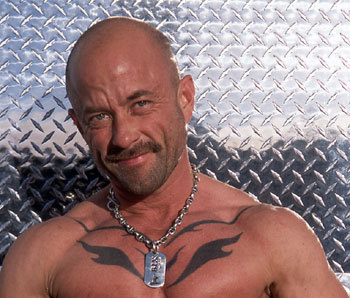
Sad to hear of the passing of Loren Cameron. In the earliest days of my transition, it seemed like his photos could be found everywhere online where there was a discussion of transmasculinity. His work was so inspiring to me!

When I started Testosterone, I hung this^ photo in my closet as inspiration. 15 years later, it still hangs there.
Cameron's photography and writing was first published in the 1996 book, Body Alchemy: Transsexual Portraits, which not only documented his transition but also the lives of #trans men he knew. Body Alchemy became a double 1996 Lambda Literary Award winner.
Cameron also published a pioneering e-book in the late 90s, Man Tool: The Nuts and Bolts of Female-to-Male Surgery. It was one of the earliest collections of photos of transmasc surgeries along with 1st-person stories about surgery experiences and post-op erogenous sensation.
More about Cameron from Wikipedia.
466 notes
·
View notes
Note
One of the best stories that include Alchemy in their plot and themes is a webtoon called The Pale Horse. If you have time check it out.
Not familiar with this, thanks.
I haven't looked at very many animated works--it's harder to analyze something when it's not based on a piece of written literature.
However, I did make a long post about the original "Frozen," here:
There is also a LOT of literary alchemy in "Elemental," which I really need to write up some time.
4 notes
·
View notes
Text
Why do we talk like that about Gintama?
So this is something I've already talked about a lot here and there, but I thought I would condense my thoughts on the topic in its own post.
We've joked a lot about math zeitgeist, but why in the world are we furiously mathposting about Gintama? Why did I write 28 pages of actual essay for it? Where does kraniumet get all those images from? (I've always wondered this.) Essentially, what's driving us to analyze these themes and motifs over and over again... and why can they be analyzed over and over again?
When I first wrote My Orochi Stood Up, I made it clear that this was an original framework made for the same purpose as all analytical frameworks and models: to enable me to gain certain key insights about the series, to account for all of its innumerable bits and pieces, and to arrange their relationships to one another in a cohesive, legible way. In short, as I wrote in my essay, it provides me with symbolic technology.
In the same vein, when I wrote my spontaneous math post, I said that so much of math is about things that don’t exist and yet become real, not just because they help you articulate something but because they help you arrive at a solution. This is the purpose of things like imaginary numbers--or negative numbers for that matter.
I know that we should never live life in accordance with the fake hater in our heads that we imagine saying stupid things to us so that we can respond to them in smart, cool ways. I'm sure Zura lives like that though, and we all think he's charming, so maybe we should reconsider this idea. What I mean to get at is that I've never once tried to claim that Sorachi literally intended any of what I describe in my ouroboros framework. I don't think he sat down one day and planned to make his motifs compatible with western alchemy, I don't think he had the creation myth of the island of Japan in mind, and I don't actually think he read Barthes.
But what's undeniable is that there is something so bizarrely consistent, coherent, and plentiful about Gintama's thematic flourishes--even though in many, many ways, Gintama is filled with bad, and worse, mediocre, writing. What sets Gintama apart from other series isn't the inherent quality of its writing (which has stark ups and downs). If you'll forgive the confusing and somewhat contradictory wording, what makes Gintama distinct isn't a quantitative difference (as in, more goodness), but a qualitative difference. What does this qualitative difference boil down to?
First is structure. This part we've gone over a lot, so I'll try to keep it brief (or novel?). Gintama is a series with basically just one favoured literary technique, and it uses it again. and again. and again. and again. and again. Parallels upon parallels upon parallels--and there are only a few key thematic ideas that Sorachi is interested in exploring. You can describe it as consistency, or, if you want to be uncharitable, repetitiveness. But it is, frankly, absurd the amount of parallels--or rather, the degree of parallelism--this series contains. What's interesting about it is its effects on how we engage with the story.
By making it obvious that this is a conscious and explicit writing decision (through various means, mainly dialogue), any characters with suitable parallelism to a prototypical character A are all connected to one other--let's call these the A-sided characters. This holds even if they're all a bit different from each other. Imagine all these A-sided characters spread out in line, like hostages tied to each track of a train track or the rungs on a ladder. They lose similarity with each rung, like loss of clarity in a game of telephone--let's call this "reflection lossiness." Even though characters in the top rung and the bottom rung may not have much in common, they may both be within "lossiness range" (<- I just made this up) of a character in a middle rung, and therefore able to communicate indirectly with one another.
Moreover, because the prototypical character A has a foil in prototypical character B, all A-sided characters are also connected not only to any individual foils they may have, but potentially to all other B-sided characters. Since it's easier to identify characters' thematic affiliations through their interactions and dynamics with other characters, the consistency of the A-B foil formula, when combined with the fact that animanga foils are generally made very obvious, helps us perceive these diagonal relationships. Thus, the reader can squint at the interactions of almost the entirety of Gintama's enormous cast with valid suspicion, with less difficulty than in other works with more complex structures. The series' sheer length also ensures that there is an abundance of material to comb through, so much so in fact that this careful inspection, through rereading again and again, becomes necessary.
For instance, the interactions between any given pair of characters may not seem directly relevant to our protagonist at first glance, but once you know the magic A | B schema, you may notice that that pair's interactions resonate with that of a different pair, one involving an A-sided character with less reflection lossiness from the top and who therefore reflects much more of what happens to them onto Gintoki. In this way, the original pair, who are probably just a couple of minor side characters who appear once in a weird arc and then never show up again, can make you go, "hey wait a minute. what if?"
What if?
Let's look at a concrete example. Housen and Utsuro don't seem to have much to do with each other at first glance. However, because we know that he parallels Kamui, and that Kamui | Kagura parallel Takasugi | Gintoki, who in turn can be mapped onto Utsuro | Shouyou, we can arrive at a Housen-Utsuro connection that wasn't previously obvious. What is the utility of this connection? For one, it sharpens our ability to articulate how the hole-sided flee from the things they fear and yearn for by adding Housen's infamous avoidance of the sun into the analysis. It also provides new ground for exploring potential ideas comparing, say, Kamui choosing to leave with the Harusame and walk in Housen's footsteps, with Oboro's resigned embrace of the Naraku and Utsuro. Additionally, since Housen was defeated in Hinowa's lap, this also helps us draw a Hinowa -> Kagura connection, which helps us arrive at a Hinowa-Shouyou connection, which helps to reify that Shouyou is a milf.
By inserting one or two blatant instances of foreshadowing and parallelism early on in the series, instances that are impossible to pass off as coincidence, Gintama primes the reader to suspect that similar nuggets might be hiding anywhere, to check every garbage can we encounter from there on out like in the Pokemon games.
Whoops. In attempting to explain the math zeitgeist I succumbed to using math in my explanation. It's irresistible.
But that's structure. Let's move on now to something arguably even more important: motifs.
It's undeniable that for a shounen series that's half gag-manga, Gintama has a strange amount of analyzable motifs, and a clear loyalty to them. Regardless of how extravagantly people on tumblr dot com may want to overanalyze their favourite Shounen Jump series, their efforts are usually restrained to theme and characterization. Their ravings do not usually resemble the ravings of the Gintama Salon. If you've read this far, I don't think I need to explain this to you, or what Gintama's most prominent motifs are. But why is Gintama so motif-ful? The sword's importance is obvious, expected even, but what differentiates Gintama from, say, Bleach, where the characters' swords also literally represent their souls in a way?
In the end the answer is what I already discussed in My Orochi Stood Up, the foundation of my entire framework, in fact its very title: the dick joke.
Sorachi's immature sense of humour is the glue holding the entire thematic and narrative structure of Gintama together. Why do we search obsessively for meaning in the flotsam of Gintama's less narratively charged moments? Because, quite frankly, many things are phallic. The sword is no longer simply a sword--by being imbued with the spirit of the dick joke, it becomes not only valid but textual to associate it with the head of the nation (shadow juice squirt), the motif of the dragon (thank you Elizabeth), and castration. What I mean is not whether the sword can be read as a dick--obviously, phallic logic has been prominent through all of human history--but the way in which Gintama's sexual humour gives us--and itself--an impetus to equate motifs in the first place.
Comparing very serious things to dicks is funny--the more abrupt, the more shocking, the more mood whiplash, the funnier is. Therefore, for Gintama's toilet humour to be as effective as possible, tone dissonance is ideal, pushing it towards the intermingling of comedy and tragedy that we know it so well for today. This in turn validates and reinforces the meaning-making role that these phallic jokes play in the story as a hole. It is not only that we cannot separate the dick jokes from the serious delivery of the plot, but that in many arcs important information is given to us through ridiculous gag devices (ball gags?).
The logic of basic sex jokes is extremely simple, intuitive, and easy to understand. The prominence of the pole necessarily implies the presence of the hole. I've talked about that enough in my essays, so I won't go into detail here, but the reason that I wrote my essays in the first place is because of how easy it is to map a procreative framework onto a series filled from beginning to end with phallic gags. As much as I may joke about it, the underlying logic of "the pole and the hole" is powerful and compelling, providing connective tissue to seemingly disparate motifs with ease. When combined with the "sorting" power of the A | B structure, the ability to associate any particular character with any particular motif easily gives us the ability to analyze how a given set of characters interacts with a motif; equally, where the motif sits in Gintama's playing ground of phallicism can inform a given character's dynamic with others.
I've already written at length about the role that wordplay plays in this as well. To save on time, I'll just quote from My Orochi Stood Up:
Gintama’s insistence on wordplay enables interesting meaning to be derived from these dirty jokes and their interaction with other motifs in the story. After all, the name of the series itself elevates the spirit of the balls joke, even if unintentionally, to the same level as the other metaphor in the title: “silver."
But perhaps the singularly most important example is the -tama in Gintama, with its plethora of potential meanings, each of them just silly and dirty enough that you have to take it seriously. Beyond the obvious joke on kintama (balls) and the “silver soul” meaning, we’ve seen that tama is also easily conflated with atama (head), and even with tamago (egg). This is clearly demonstrated with the series’ fixation on beheading leading to the salvation of the soul, and the bodyswap arc hinging on the pun between soul and egg.
In short, it is the comedic aspect of Gintama that fuels the series' own willingness to conflate and play with its motifs, and that validates--provokes--our mad efforts as readers to draw unlikely connections and dig through dirt. Though it may seem more ridiculous on the surface to be taking such a magnifying glass to such a profoundly silly series, it is in fact more justified for Gintama than it would likely be for a more serious series, one where the paths between motifs are not pre-paved, let alone lubricated with shadow squirt juice.
I was recently introduced to a theory of comedy where comedy was posited as an interplay between excess and lack. How this maps on to Gintama is obvious; but one thing that comes to mind now is how easy it would be to characterize our scholarly efforts in examining Gintama, a series one could humorously characterize as "lacking", as a kind of excess. Which is to say, I think Gintama has pulled its penultimate trick on us (because it's still coming out with more stuff for the anniversary. I believe it.) by making us part of its comedy.
54 notes
·
View notes
Text
Week Two of The Raffle is Here!

Week two of the raffle benefiting Scarleteen is underway! This weeks’ theme is: treat yourself! The prizes on offer are all about self care and pleasure!
Tickets start at just $5! We also have deals on multi-ticket purchases open to everyone, and a ‘buy one get one’ deal on up to 5 tickets, open to all new and existing recurring donors.
And thanks to a generous donor offering up to $5000 in matching donations, every ticket you buy has double the impact!
You can find all the prizes below, including scents from Black Phoenix Alchemy Lab, a gift card for Aisle Period Products, and literary teas from Rosefinch Mercantile! You can also see all the prizes listed here.


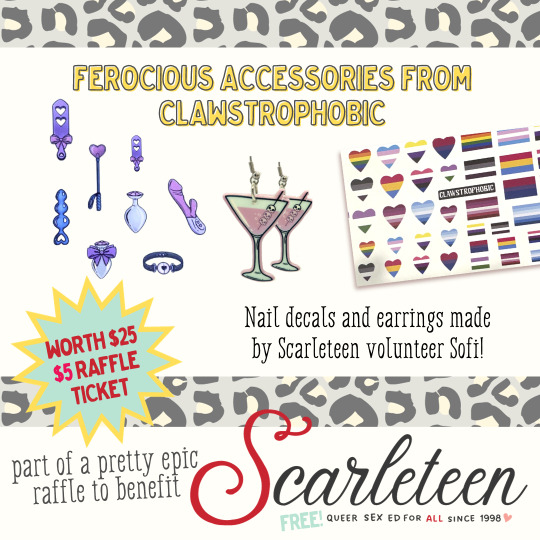












65 notes
·
View notes
Text
Mona, Albedo, and Wanderer: Truth-Seekers & Defiers of Fate
Cross-posting from HoYoLAB.
What do an alchemist, an astrologist, and a wanderer have in common?
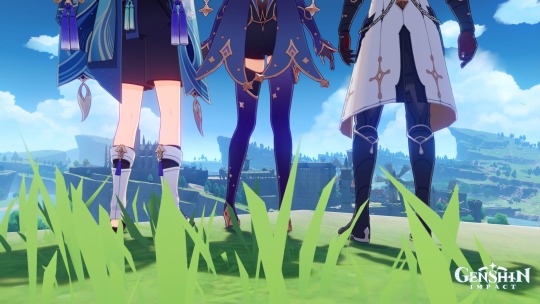
A lot, as it turns out, in terms of design, literary themes, and lore implications.
Allow me to connect seemingly unrelated dots between these three characters. Perhaps by the end of this you too will be eagerly anticipating an event or quest that features all three some day.
Scholars
Albedo is a genius alchemist, working for the Knights of Favonius as Mondstadt's Chief Alchemist. His knowledge in alchemy goes beyond what even the Sumeru Akademiya possesses, the Art of Khemia from Khaenri'ah.
Mona is a genius astrologist and one of the few practitioners of Hydromancy. Her reputation as an astrologer led to her being asked to take on the All Things Astrological column in Fontaine's newsletter, The Steambird. Her work is revered in the Rtawahist Darshan at the Sumeru Akademiya.
Wanderer, known as ‘Hat Guy’ among the students of the Vahumana Darshan, has become an ad-hoc student of theirs after his papers refuting the popular academic theories surrounding the Tartarsuna incident became popular. He later wrote pieces about Inazuman politics that garnered acclaim. Apparently having a knack for academia, he’s been invited to Vahumana lectures and was able to serve as its representative in the Akademiya Showdown.
Appreciators of the Arts
Albedo is an artist, who has illustrated A Legend of Sword books under the pseudonym Calx and was invited to Inazuma during the Irodori Festival held after the nation opened its borders to illustrate the Five Kasen paintings.
Mona enjoys singing and does so while stargazing. During the 2.8 Summertime Odyssey event, she accepts Xinyan's offer to give her voice lessons.
During his time as Kabukimono living at the Mikage Furnace, he learned how to sword dance and would perform alongside the other blacksmiths. His talents and their excerpts, constellation, and namecard reference theater and poetry, which may indicate his interest in those arts.
The Sun, Moon, and Stars
The Geo construct Albedo creates is called the Solar Isotoma, and his 3rd Constellation is titled "Grace of Helios".
Albedo's namecard is titled "Sun Blossom".
Albedo's splash art and Solar Isotoma design features flower and sun-like imagery.
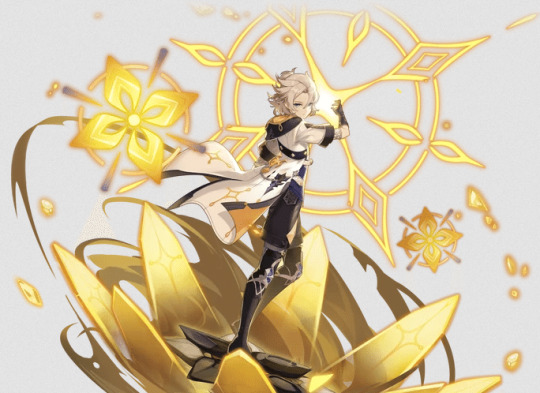
The name, Mona, means "Moon" in Old English.
Her redesigned outfit is titled "Pact of Stars and Moon" and features crescent moon pendants on her hat and leg.
The eight-pointed star on the pendants has likely influence from the Star of Ishtar, the inspiration for Teyvat's Istaroth, who may have some connection to the three moon sisters.
Her 2nd constellation is titled "Lunar Chain".
Mona's namecard is titled "Starry Sky".
Naturally, as an astrologist, she also has countless star-related symbolism which are fairly obvious.

Two of Wanderer's constellations have moon-related names. His 2nd constellation is "Niban: Moonlit Isle Amidst White Waves" and his 3rd constellation is "Sanban: Moonflower Kusemai".
Interestingly, Wanderer's splash art is different from most other Anemo characters in that the elements surrounding him are more black and navy than turquoise, and features a galaxy and star design.

What defines a human?
Albedo and Scaramouche are both artificial beings, homunculus and puppet respectively.
Albedo was created by his mother, Rhinedottir, using an ancient technique from Khaenri'ah called Khemia. He was part of her Primordial Human project and was the last of her (known) creations, considered her magnum opus. The only evidence of his being a creation is the pontil mark she left on the front of his throat, his one "imperfection" that makes him human. Rhinedottir considers him her son and only child left.
Wanderer was created by his mother, Ei, using an ancient technique now lost. It's implied Irminsul was used in his creation. He was the prototype puppet made for the purpose of storing the Electro Gnosis, but was deemed too weak when he cried while storing it and was thus left to sleep in Shakkei Pavilion with only a plume to signify his connection to the Shogun. He bears the Electro symbol on the back of his neck, the complement to Ei's.
It's unknown whether Albedo is immortal or ages differently than humans, while Wanderer has lived for nearly 500 years, created just after Makoto's death during the Cataclysm. He has always appeared as a beautiful young man, never aging.
In Mona's voicelines about other characters, she almost always references their constellations and interprets parts of their fate from them. The only exception is her voiceline about Albedo. It's speculated that the reason Mona doesn't comment on it is that she's aware of him being a homunculus and purposefully does not reveal his secret.
In the same vein, when Mona first meets Scaramouche during Unreconciled Stars, she is immediately able to see through his facade and tell that he is both a Fatui Harbinger and that he had killing intent towards the Traveler. After Mona teleports the group away, Scaramouche himself wonders if she was able to figure out his true identity—which, during 1.1, players take to mean him being a Harbinger. Looking back, it's likely he meant him being a puppet with powers close to Archon level.
Albedo and Wanderer both represent questions about what makes one human, on both a physical and spiritual level.
"The difference between synthetic and natural life lies in the directional flow of the life force. The energy of a natural life form flows out from within. That's why flower buds bloom and curled leaves unfold. It is the very reason we watch in wonder at blossoming flowers. Creating life artificially, on the other hand, involves — to a certain extent — the introduction of an external source of energy into the embryonic life form. When the hole where the life force was infused is sealed at the end, it leaves a mark not dissimilar to the pontil mark in blown glass wares. The alchemical substance drips and spreads out in all directions, resulting in this rather ingenious diamond shape.
This mark is a sign of my artificial origins, and proof of my imperfection as a human."
Albedo, Shadows Amidst Snowstorms, Act II: The Shadow Deepens
"But Subject Two wanted to become a perfected human. So, he erased the mark on both his and Subject Three's necks, for these marks were a symbol of imperfection... He so desperately craved to become a perfect human being that he forgot something: Human beings are defined by their flaws."
Albedo, Shadows Amidst Snowstorms, Act III: A Secret Born From Ashes
"As beings who set foot in this world, how arrogant are we in desiring to control our destiny, and in desiring to create?"
Albedo, Shadows Amidst Snowstorms, Act III: A Secret Born From Ashes
Wanderer: In your eyes, are there any differences between humans and puppets?
Nahida: Do you think there are any differences between your present self and your previous and future incarnations? If not, then what are the differences between humans and puppets? Whoever has tasted the joys and sorrows of life in the human realm is human. Whoever has loved and lost, cried with grief, howled with rage at the tragedy of death that eclipses the miracle of life... they are human, too.
Wanderer: I've always believed that human lives follow a set of rules, with each person being a collection of past experiences. As a puppet living in the human world, my life is subject to the same rules. I've lived with a void in my chest my whole life. My creator didn't need me, and ever since I awoke, I've just drifted from one place to the next. But then I met you, and I finally realized that reclaiming my missing sins might be my one opportunity to become my true self. I've always felt I have an innate tendency to yearn for something more, in a way that goes deeper than for most people... But for all my soul-searching as a shugenja, I've never fully understood it. Looking at it now, it seems that I brought this curse upon myself. So I beg you... grant me this opportunity to gain a purpose. To change my destiny and end my wandering.
Wanderer and Nahida, Interlude Chapter: Act III: Inversion of Genesis - The Kabukimono's Finale
Nahida: To be human is to live with imperfections. You can choose whether or not you want to be human.
Wanderer: ...But humans can't live without a heart, can they? Anyway, I gave up trying to become a human a long time ago.
Nahida: You understand what pain is perfectly well, even without a heart. You're just burying your feelings. The past is set in stone, but you can keep moving on. And the longer your future lasts, the shorter your past will become, until one day it is but a tiny fraction of your life.
Wanderer and Nahida, Interlude Chapter: Act III: Inversion of Genesis - As Though Morning Dew
We can see the similar themes of questioning what it means to be human, of recognizing and accepting imperfections as a part of their humanity for Albedo and Scaramouche.
How does Mona tie into all this? She isn't an artificial being. (As far as we know.)
Mona's Character Story 5 talks about similar themes, namely human hearts and the laws that (supposedly) govern them.
During her apprenticeship, Mona found that the subtle abstractions of her master's teachings could explain the laws that governed the existence of all things. Human hearts were guided by these laws, and if one had great enough powers of calculation, all the mysteries of the world could be understood.
Mona once believed this to be true.
But when she had to strike out on her own and live day-to-day, she found herself doubting. Not everyone lived wealthy and comfortable lives. Some neither had food nor warm clothes, living no differently from beggars. And it was just such an adventurer who, when meeting Mona while she was out looking for fruits and vegetables to fill her stomach, shared half their food with her.
"Out here, we've gotta have each other's backs."
This was not something inscribed on these so-called principles of the world. And many other such things she encountered on her journey — the honesty of a thief, a robber's change of heart, a coward's courage, the good deeds of a wicked person... Mona began to have some doubts, but she also felt like she finally had her feet on solid ground. When she was again alone with her thoughts under the stars, she marveled that her research had been so full of holes. Perhaps she would have to continue researching the world's principles for the rest of her life.
We see these same questions brought up by Wanderer at the start of his journey of repentance.
This story of the adventurer she meets is the same one that Mona references during her mirage in the Summer Odyssey event. She divined that if he continued adventuring, he would meet his death within two years. Despite this, the adventurer continued on. Mona believes him to be dead now, since fate is immutable and that encounter was over three years ago.
It's speculated that this adventurer is none other than Joserf, who gets lost on Dragonspine and does indeed meet his death. Except that during the Shadows Amidst Snowstorms events, Albedo uses a whopperflower to bring new life to "Joserf" and reunite "him" with his son, Joel.
In doing so, is Albedo rewriting fate?
Irminsul, Fate, and the Truth of the World
We know that Irminsul is tied to the fate and truth of Teyvat, and all three characters have ties to these themes.
Mona and Albedo are both apprentices/inheritors of knowledge of Hexenzirkel members: Barbeloth and Rhinedottir. The Hexenzirkel is known to embark on Irminsul explorations (which Albedo accompanied Gold on) and at least two members, Alice and Nicole, are implied to be immune or able to know when Irminsul tampering occurs.
Mona and Albedo share a common goal: to uncover the truth of this world. Albedo was tasked with this by Rhinedottir before her abrupt disappearance after discovering the Heart of Naberius, while it's currently unknown if Mona inherited this goal from Barbeloth or if it's her own.
Both are foreshadowed to incur a dark fate in their pursuit of the truth. In Mona's Collected Miscellany, Dainsleif says, "But beware, O young seeker. You must sacrifice your all to unravel the world's secrets," while Albedo is foreshadowed to lose control of his power or be susceptible to corruption and endanger Mondstadt.
As a student of the Vahumana Darshan, Wanderer studies the truth of history.
During his time as a Fatui Harbinger, Scaramouche was sent on missions to the Abyss by the Fatui, implied to be because of his ability to withstand and recovering from damage/attacks. We know that truly ancient Irminsul is located in the Abyss.
He is implied to be created from Irminsul and can navigate the memories stored within, as seen in Inversion of Genesis.
He tried to rewrite the past/fate by erasing himself from Irminsul but learns that fate cannot be changed. This is a line we hear often in game from none other that Astrologist Mona Megistus.
In the confrontation between Dottore and Nahida in the Akasha Pulses, the Kalpa Flame Rises, we learn that Irminsul hides the secret "truth" that "the sky and stars of Teyvat are fake".
This corroborates what Scaramouche said in Unreconciled Stars: that the stars, the sky are all a gigantic hoax. A lie.
Mona also corroborates what Scaramouche revealed: she said she was taught to talk about the false sky in her readings.
This means both the Fatui and the Hexenzirkel are aware of the false sky.
In Conclusion
Coincidentally (or perhaps not) all three were sent to Mondstadt.
Albedo was instructed by Rhinedottir to seek out Alice in Mondstadt and take up residence there.
Mona ends up in Mondstadt after being sent to retrieve something of Barbeloth's from Alice's successor (Klee) and when she accidentally reads her 50 year old diary, she feels forced to hide in the city lest she incur her master's wrath.
Scaramouche was chosen by Pierro to investigate the meteorites in Unreconciled Stars, and he speculates that the Jester not only knew what he would discover about the false sky, but that he wanted to frighten him with this information.
I believe all of this is building up the three of them meeting, whether as allies or rivals, in connection with the false sky/truth of the world plot. I feel there are too many connections between them for it not to be intentional.
Or it's all copium!
Bonus
Additional tidbits that didn't fit in with the rest.
According to Mona and Klee's voicelines, Albedo and Mona are friends/colleagues and meet regularly for meals and to play with Klee.
In the Irodori Festival, Albedo paints Kuronushi of the Five Kasen based on Scaramouche's likeness, which was only revealed when Hydro was applied to the canvas. Similar to the concept of Hydromany, which divines truth in the reflection of water.
The forging technique passed down from the Raiden Shogun to the Raiden Gokaden incorporates astrology into its process.
Barbeloth, Mona's master, likes hats and helps pick them out for people. (Like Klee, and maybe Mona as well.) She would probably appreciate Wanderer's taste in hats.
#genshin impact#genshin theories#scaramouche#albedo#mona megistus#hexenzirkel#fatui#bloo writes theories#long post
88 notes
·
View notes
Text
Syzygy, or Animus and Anima: Weiss and Jaune
Anima-Animus anon, here is your meta. I genuinely do think Weiss and Jaune are one of the best literary examples I've seen of animus and anima, respectively. This is not inherently a shipping meta, although you could read it that way.
Of note: I did talk about Jaune and anima before here in a larger meta about his arc, and about Weiss and animus here. But I want to talk about their arcs because they are complimentary, and really encapsulate how to write anima and animus pretty perfectly.
So let's go over it. What is anima? What is animus? How is Jaune one of Weiss's animuses? How is Weiss one of Jaune's anima? And what does this mean thematically for their arcs and the work of RWBY as a whole?
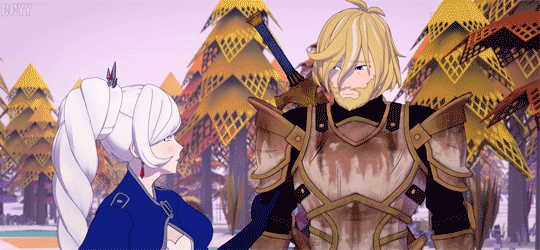
Jungian Archetypes
I have a whole meta on Jungian archetypes in RWBY. But I just want to quickly go over some of them because I'll use these terms in the meta.
Persona: the part of ourself we present to the public. It's usually somewhat fake, or at least societally acceptable.
Shadow: the part ourselves we repress because we do not want to acknowledge the parts of us that are selfish, hurting, weak. End goal: integration with the shadow and accepting that these are parts of you. In literature, the shadow is often negative or antagonistic if embodied in a character, because facing it requires facing character flaws. However, only by integrating with the shadow do we start to heal. It's necessary to become a complete person. Associated with the Black stage in alchemy, and with Blake.
Anima/animus: the feminine/masculine within ourselves. This can overlap with the shadow in some ways (for example, men often don't want to admit that they're weak). Anima/animus can be positive and negative. Associated with the White stage in alchemy, and with Weiss and Jaune. You don't have to interpret it as romantic, but it often is.
Self: The Self is the end goal of Jungian psychology: achieving individuation, or the fullness of being who you are and knowing your role in the world. Associated with the Red stage in alchemy, and with Ruby.
Syzygy: the union of anima and animus.
Lastly, I want to disclaimer about the terms "masculine" and "feminine" here. Jung was writing at a time when gender binaries and roles were very much a thing. Of course they apply less today (and RWBY deliberately plays with some of these, as we'll see). But when I use the term "masculine" or "feminine" in this meta I mean in the traditional sense Jung is talking about. Masculine=bravery, physical power, fear of the weak. Feminine=beauty, emotions, kindness, etc. Please note this is clearly oversimplified and I am not endorsing this, just explaining a pattern that Jung pointed out in regards to literature.
Jaune and Anima
Between anima and animus, anima is more likely to be romantic in fiction. That's because Jung associated anima with something he called Eros (Greek for romantic/sexual love). A man's anima is also almost always one person at a time. This is not the case with animus, as we'll see.
Hence, the two women associated with Jaune's anima are Weiss and Pyrrha.
The previous meta I did on Jaune's arc makes a strong argument that Pyrrha firstly embodies his anima. She almost perfectly goes through the first three of four stages of anima in regards to how Jaune views her, which are:
Eve (mother)
Helen (romantic interest)
Mary (religious devotion)
Sophia (wisdom, guide to the inner life)
I would also argue that Pyrrha embodies Sophia too here, but the living Sophia is also Weiss. Sophia is Greek for "wisdom," and both the official RWBY Twitter account and the show itself make the connection explicit for us, with the Curious Cat calling Weiss "wise Huntress."
But it's also deeper than just stages here. Jaune's entire arc is about the rejection of toxic masculinity and the embrace of his own role as maiden. Only through becoming a Maiden (in other words, embracing the feminine within) can he become a Knight (the man he was meant to be).
Jaune As The Maid of Orleans
Jaune's allusion is, of course, Jeanne d'Arc. He has a feminine allusion, which tells us to expect his integration with the inner feminine. Joan of Arc was also know as three things:
A spiritual guide to France in wartime
A soldier/knight
A maiden
In real life, Joan of Arc was dismissed because she was just a girl... until she started actually winning battles and her predictions came true. God or not, there's something really powerful and intriguing and eerie about her story. Joan of Arc referred to herself as "Jeanne la Pucelle," or "Joan the Maiden."
But what is a Maiden? In Joan's time, it literally meant "virginity," because there was a prophecy that France would be restored by a virgin. In other words, her virginity was a strength--spiritually, at the time period, her going to war with men yet maintaining her virginity was seen as a sign of righteousness (yes, it was very anti-sex).
In RWBY, a maiden is also hardly a weakness. No, a Maiden is a specific type of power.
It's also associated with martyrdom.
Jaune has had special relationships with several of the Maidens in the series: firstly, Pyrrha, who chooses to kiss him (a nice pro-sex commentary honestly) before dying as a Maiden even though the power had not been transferred to her. Pyrrha ends up a martyr like Joan of Arc, but her legacy, like Joan's lives on. Pyrrha embodies what Jaune should become.

Penny, of course, dies as a martyr too. She is stabbed by Cinder and there isn't time to save her. Jaune, who defines himself as a healer thanks to his semblance, has no choice but to kill her so that Penny stays in control of her destiny. It's tragic, but like Pyrrha, it isn't empty.
Of course, Cinder has now killed Jaune's first love interest, tried to kill another (Weiss), and then made Jaune into a killer via stabbing Penny. Hence, Jaune and Cinder are also linked, and the message of what a maiden should be, and what destiny is--the message Pyrrha carried, the message of choice embodying destiny that Penny carried--is something I suspect Jaune will give to Cinder before the end.
Still, all of these incidents, the three big alchemical deaths of the series--Black Death, White Death, and Yellow Death (Crocea Mors)--involve Jaune and specifically switch the gender of what you would expect from a hero.
The Knight is supposed to protect the Maiden. Instead, the Maiden kisses Jaune and locks him away to save him while she fights Cinder. Jaune is supposed to protect the Maiden, but she (Weiss) gets impaled precisely because he couldn't get over his previous failure to save Pyrrha. This time, though, he saves Weiss.
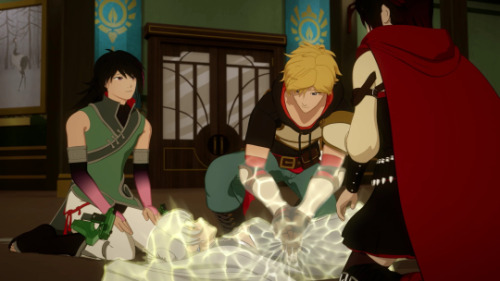
The thing is, though, that healing is traditionally a feminine attribute. Hence, Weiss lives and Jaune heals because, symbolically, of his ability to embrace the inner feminine.
Lastly, the Knight is supposed to save the Maiden. But instead, saving the Maiden looks like becoming the monster himself, like becoming his shadow (which Cinder is). It shatters his sense of self, as we've been seeing throughout Volume 9.
If a Knight is also a dragon killing a maiden, who is he?
Jaune As The Rusted Knight
Jaune's sword is broken, and he intensely clings to this persona of "knight who saves" the entire volume. But by intensively insisting on saving the Paper Pleasers, he doesn't realize he's repeating what Ironwood et al did to Penny: refusing to allow them their own right to choose their destiny. He also fails to save Alyx.
Jaune's "knight who saves" persona has been a key part of his character since the first season. He cheats to get into Beacon because he wants to be a hero and carry on his family's legacy. He's embarrassed to be so weak, but the only way to become strong is to rely on women. Team RWBY, Pyrrha, even Nora and Ren (who don't fit gender stereotypes themselves).
Pyrrha literally trains Jaune. Notably, whenever Jaune relies on male advice, he fails. In fact, his knight persona is precisely why Weiss doesn't like him at first (not just romantically; like, at all.)
Weiss: (separating the two) Jaune, is it? Do you have any idea who you're talking to?
Jaune: Not in the slightest, snow angel.
Jaune: I don't understand. My dad said all women look for is confidence! Where did I go wrong? (accepts Ruby's offered hand and uses her to lift himself back up)
Yang: "Snow Angel" probably wasn't the best start.
Jaune's confidence and understanding of women coming from his dad instead of like, actual women, means he's going to make an arse of himself. And he does. At first.
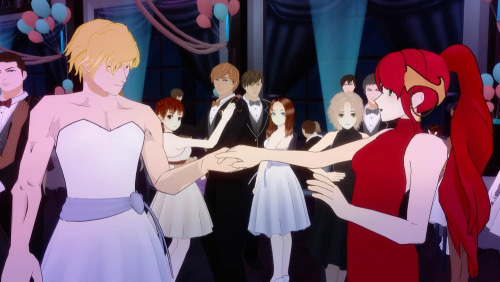
But, Jaune starts to integrate with the feminine through not just Pyrrha training him physically, but also through doing things like dressing up as a princess and going to the dance like that to honor his word to Pyrrha. He gets closer to Weiss by talking to Neptune about feelings rather than by impressing her through feats of strength. He then saves her life via delving into a traditionally feminine power. And in the end of Volume 9, he is restored to his young self via Alyx, the girl he thought he couldn't save.
Weiss and Animus
Oh boy, animus.
Okay, so... Jung did not write nearly as much about animus as he did about anima. Supposedly that's because he's a dude and recognized that he could not actually experience animus. Fortunately, his wife Emma wrote a lot about it, as did some direct colleagues (like Marie-Louise von Franz) who specifically applied animus to its portrayal in fairy tales.
Animus differs from anima in a few key ways. The centrality of the concept--that it's the masculine within a woman--remains the same. However, animus:
is not usually limited to just one person at a time like anima;
doesn't follow stages nearly so neatly (they exist but are a bit... debatable)
is not inherently based on Eros, or a romantic understanding. No, instead animus is based on Logos.
What is Logos? Logos is literally "word" in Greek, but the actual usage is more akin to "mind" or "spirit." Weiss, of course, is a mind character. It can also refer to the principle of the matter. In other words, a woman looks for her masculine traits in a principle she holds dear.
Jung himself said:
The male personification of the unconscious in the woman — the animus — exhibits both good and bad aspects, as does the anima in man. But the animus does not so often appear in the form of an erotic fantasy or mood [as the anima often does to men]…even in
a woman who is outwardly very feminine the animus can be an equally hard and inexorable power. One may suddenly find oneself up against something in a woman that is obstinate, cold and completely inaccessible.
Weiss as Princess Snow White

Weiss starts off possessed by her negative animus, the Logos or principle.
What is animus/anima possession? It's specifically a negative manifestation of the animus (or anima) wherein someone behaves overwhelmingly like their masculine side--but in a negative sense. In other words, for Weiss, this looks like a persona of toxic masculinity.
Possession caused by the anima or animus presents a different picture... The animus is obstinate, harping on principles, laying down the law, dogmatic, world-reforming, theoretic, word-mongering, argumentative, and domineering.
I kinda do think this sounds like early-volume Weiss. But it also sounds like... Jacques Schnee.
See, the animus is also often a reflection of a woman's father. Even though Weiss is determined to prove herself without her father's influence by the start of the series, we also see that she is in some ways behaving like him. Of course she's not nearly so ruthless or bigoted, but she does maintain some prejudice about faunus, maintains entitlement (demanding to be leader of RWBY), tells off Ruby for accidents, etc. She's denying her femininity.
But then her development starts, and with this, her animus changes. Who are her animus?
Well, as I said above, animus has multiple presentations, and for Weiss they're specifically unique... because some of them are women. Make of that what you will, shippers and headcanoners. I'm not just going off of nowhere in saying that I think some of Weiss's masculine animuses are women, either; I'm specifically talking about it in regards to Weiss's allusion of Snow White.
You can find numerous fairy tale analyses with animus/anima interpretations. Snow White is one of the most obvious ones. But Weiss's Snow White is genderbent... mostly. Except for her.
See, in the Grimm version of the fairy tale, Snow White's father is alive. He just does absolutely nothing to stop his wife from abusing Snow White. In this story, Willow, Weiss's mother, is the absent one, doing absolutely nothing to stop Jacques from abusing her children. As a result, we have the Shadow develop--in the fairy tale, the Shadow is the Evil Queen. In Weiss's story, it's Jacques. He is who she doesn't want to be, but does have similarities to especially in her persona.
Snow White then meets nine other men. Yes, there are a total of ten male characters, and they are all aspects of animus. In the original Snow White fairy tale (reference this analysis), we can break it down as such:
Absentee dad
Huntsman
Seven Dwarves
Prince
In this, we can see slow progression of Snow White's integration with her masculine side.
Firstly, it's denied to her (she's completely out of balance) because her father refuses to take any action and is never mentioned again.
Secondly, the Huntsman takes action and spares Snow White from the queen, but also doesn't exactly help her. He sends her off into a dangerous forest to fend for herself.

Thirdly, we see reciprocity finally appear. Snow White helps the dwarves, but they also help her. It becomes a mutual relationship in which she learns from all seven of them.
Lastly, Snow White is revived thanks to the prince, who marries her as an equal.
When we compare this to Weiss's arc, we see similarities. Willow is absent, denying her what she needs. Then, Winter play the role of the Huntsman, helping Weiss forge her own way to a degree but still leaving her to rely on herself when she could maybe use a bit more help.
Thirdly, Weiss meets RBYJNPR: her seven dwarves. She learns how to be herself, learns who she is, in great part because of them.
Lastly, this volume we have her developing an attraction to Jaune, whom she knows and who has revived her. She gets to be fully Prince and Princess.
What About Stages?

The stages of animus, when they exist, are loosely defined (as in Jung himself didn't actually say this, but is often attributed as having said it) as:
Tarzan: physical power
Byron: man of action or romance
Lloyd George: man as a professor or orator
Hermes/Mercury: man as a spiritual guide
If we look at this through the lens of Weiss's arc, we do see traces of these. The physical power Weiss is attracted to is embodied in Winter and Pyrrha. I mean Weiss specifically calls out Pyrrha's physical strength when she meets her:
Weiss: So, Pyrrha, have you given any thought to whose team you'd like to be on? I'm sure everyone must be eager to unite with such a strong, well-known individual such as yourself!
Weiss: This will be perfect! The smartest girl in class combined with the strongest girl in class! Together we will be unstoppable! I can see it now! We'll be popular! We'll be celebrities! We'll get perfect grades! Nothing can come between us now!
The man of action/romance is embodied in the Rusted Knight persona, and in Neptune, who is notably a giant flirt.
As a professor or orator, I would actually say there are many here. Klein, of course, reminding her who she is. Then there is Robyn, who is probably the most obvious orator in the story. Also Ironwood. Basically, thanks to Robyn having the election stolen from her, Weiss helps take down her dad. As a result, her mother returns to her (the feminine returning) and she is able to get Whitley to help save them all (integrating the masculine).
We also see a little bit of this later on with Jaune, in that Weiss expressly says she admires his maturity.
The technique of coming to terms with the animus is the same in principle as in the case of the anima; only here the woman must learn to criticize and hold her opinions at a distance; not in order to repress them, but, by investigating their origins, to penetrate more deeply into the background, where she will then discover the primordial images, just as the man does in his dealings with the anima.
We're not quite there with Hermes/Mercury, and I would bet that Jaune won't fully become gold or a spiritual guide unless he, well, has something to do with saving Mercury Black. The allusion is too literal not to be used.
Weiss as Knight
Weiss has always been a knight in addition to being Snow White, a maiden princess. Weiss defeats a knight-like creature (Arma Gigas) in the White trailer, and then goes on to be able to summon Arma Gigas as part of her semblance thereafter.
She's exceptionally talented in combat. In fact, the person Jaune calls to save Pyrrha when she's gone to fight Cinder is Weiss. He begs her to save Pyrrha, and Weiss promises him she will.
Sadly, just like Jaune in his attempts to be a knight, she can't, but not for lack of trying.
Later, in Volume 5, we see Weiss receive a power up that comes from her soul (another word for anima). The knight imagery becomes even more part of her semblance, as @aspoonofsugar has written. Notably, she summons Queen Lancer (literally referring to both the maiden-princess and knight archetype) after Jaune heals her in Volume 5. In other words, it's part of her integration with Jaune.

Then, Volume 8 happens, and Jaune again tries to rely on Weiss. He insists to Penny that "Weiss will buy us time" to heal Penny. And she would have tried (and probably died). But Penny tells Jaune that he's the one she needs to do something brave. It's his time to be a knight.
Weiss similarly expresses confidence that Jaune would have done the best he could after she arrives at the Ever After, unaware that he's fallen, too. Even as they go through the Ever After, Weiss affirms her Logos: herself, which is defined by her heroism and her failures.
Weiss: I don't know who you think you are, but let me tell you who I am. I am the granddaughter of a hero and the child of a villain. I am a citizen of a fallen kingdom and an heir to nothing. I will not be defined by my name because I will b e the one to define it. I am Weiss Schnee, and I am a Huntress.
And then we have the finale of Volume 9. Here, Weiss is the one to give Jaune words of wisdom, to encourage him after the Paper Pleasers return as jewels and Jaune realizes that he was not only holding them back, but holding himself back (literally, Jaune, despite being older, has not grown at all emotionally; he's stagnated. He's not a 40 year old in a teen's body; he was a teen in a 40 year old's body). Weiss tells Jaune what she told her younger self:
Jaune: I wanted the rush of rescuing someone, and I got that here.
Weiss: I think you're asking too much of yourself. We've been telling ourselves that failing means we're no good. But I can guarantee even the best Huntsmen in history? They've all lost. But they were still incredibly brave. And good.
In response to this, Jaune starts to cry (a traditionally feminine trait!), and Weiss asserts again what her Logos is: being a knight and a maiden, being brave and good, even when that means you can't save everyone.
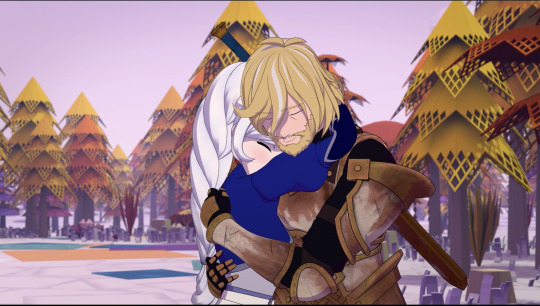
So then they fight together, again.
But it's another reversal. The princess, instead of being saved by the knight, almost kills the knight with fire in a scene that comments on what happened with Pyrrha, Jaune saving Weiss, and Penny.
Integration of Knight and Maiden
What's interesting about the Pyrrha-anima-animus connection is that it is Weiss who introduces Jaune to Pyrrha in the first place. Weiss wants to be Pyrrha's partner, actually. She deeply admires Pyrrha, as shown as she says about her and Pyrrha in that first meeting:
Nothing can come between us now!
What immediately comes between them is Jaune. Literally.

But it's not Jaune coming between them in an icky two girls can't get along because of a boy love triangle way. No, instead it's the three of them united because of their relationships with each other.
In that same scene, the very first, we have Weiss literally asking Pyrrha to intervene and get Jaune away from her by throwing her spear... which she does. The symbolism of Weiss asking Pyrrha to throw her spear into Jaune is uh. It's Freudian. Let's leave it there.
In fact, Jaune's feelings for Pyrrha start to develop as a result of her training him physically and encouraging him about his crush on Weiss. Hence, Weiss has been a part of Jaune and Pyrrha's relationship since the start of it; all three of them have an inextricably intertwined relationship.
Then, when Pyrrha says goodbye to Jaune and kisses him, it's right before shoving Jaune into a locker, the same as the ones she met him in front of. This time, when Jaune's in trouble, he calls Weiss--understanding that he needs someone else to save Pyrrha, and trusting that Weiss can do it. Jaune calls Weiss, because she's a knight. Unfortunately, she can't save her.
In Volume 5, Jaune saves Weiss precisely because his grief over Pyrrha contributes to Cinder impaling Weiss. Pyrrha is central to Weiss and Jaune's bond. Pyrrha and Weiss have always been intertwined as Jaune's anima, and if they do end up going with romantic White Knight, they would never have happened if it weren't for Arkos.
While I often see early-volume!Jaune's feelings for Weiss dismissed as shallow, I don't think they actually are. I think they're immature, sure, but look at what he tells Ren about Weiss:
It's Weiss... I'm completely head over heels for her, and she won't even give me a chance. She's cold, but she's also incredible. She's smart, and graceful, and talented-- I mean have you heard her sing? I just wish she take me seriously, y'know? I wish I could tell her how I feel without messing it all up.
Jaune clearly always did see the actual Weiss, not just her beauty, physical strength, or name. Yes, he was initially attracted to her persona, but the undercurrent was always real. Even Snow Angel.
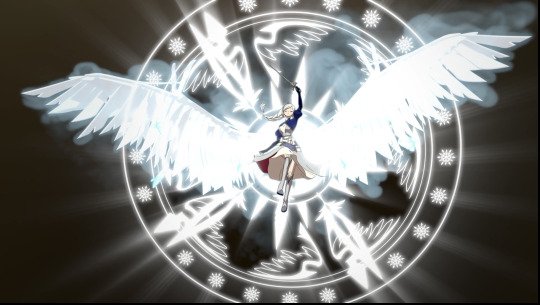
The problem is that Jaune could never be with Weiss if he remained in his Knight persona, expecting her to take the princess role. No, instead, they both have to be knight and princess.
Knight and maiden have never been more clearly integrated than in Volume 9's portrayal of Weiss and Jaune. Jaune is the legendary "Rusted Knight." But, he turns out to still be a Maiden literally waiting around a tower/house for rescue in the form of Team RWBY.

When the Jabberwalker comes, Jaune and Weiss fight together just like Bumbleby fight together; this is explicitly paralleled. (Also, Weiss kind of ignores her fighting partner, Ruby, which contributes to Ruby's feeling lonely; this isn't inherently wrong because they like, needed to stop the Jabberwalker, but it still, well, is, and is also emblematic of Ruby feeling left behind).
During this fight, Jaune tosses his sword to Weiss, who expertly wields it despite it being broken and then gives it back, therefore symbolizing that Weiss can be the knight, that she can be the masculine one, and letting her do so is actually not emasculating for Jaune. Instead, it's realization of his potential in being both knight and maiden.

(And, let's not get into the very very basic Freudian symbolism 101 of a woman using a man's sword.)
The Maiden, instead of being saved by the knight, almost kills the knight with a baptism of fire.

In fact, in Jung's own writing on the philosophical tree (yes, really), he notes this:
The lapis signifies the inner man... the natura abscondita which the alchemists sought to set free. In this sense the Aurora consurgens says that through baptism by fire "man, who before was dead, is made a living soul."
...
The genuineness or in-corruptibility of the stone is proved by the torment of fire and cannot be attained without it. This leitmotiv runs all through alchemy.
What is funny here is that Jung uses "lapis" here to mean the philosophical stone, which is most commonly called a ruby. But it can be a sapphire, or apparently a lapis lazuli. Go google the color lapis and tell me that that is not exactly Weiss's dress color.
Like Joan of Arc, Jaune is consumed by the fire. He is coagulated after the dissolution of the Paper Pleasers. But instead of coming forth as ashes, he comes forth as gold... with some growth still ahead and with some white streaks in his hair, symbolizing integration with the feminine (white=feminine in alchemy and Jung).
So where do Weiss and Jaune go from here? Jung provides a clue:
“Just as the anima becomes, through integration, the Eros of consciousness, so the animus becomes a Logos; and in the same way that the anima gives relationship and relatedness to a man’s consciousness, so the animus gives to a woman’s consciousness a capacity for reflection, deliberation and self-knowledge.”
C.W. Vol 9. Part II: Aion. The Syzygy: Anima and Animus
Both Jaune and Weiss have done this for one another thus far, and will continue doing so. Neither Weiss's nor Jaune's arcs are entirely over, either: Jaune still needs to fully embody the spiritual guide, and Weiss needs to embody wisdom and they are both so close but still have a bit more to grow.
#anima#animus#rwby meta#white knight#weiss schnee#jaune arc#pyrrha nikos#arkos#jung#alchemy#a bit#rwby#rwby volume 9
105 notes
·
View notes